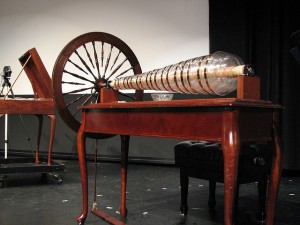Ben Franklin’s Glass Armonica
The glass armonica is a series of 37 spinning, color-coded glass bowls that create sound when friction is applied. The glass bowls are precisely sized, and vibrate to create sounds. The bowls spin by means of a foot-operated treadle, much like a spinning wheel. The glass armonica creates a wider range of tones than a set of filled glasses could, and it eliminated the need for standing liquid – and its obvious disadvantages!
Frankin’s design also allowed the musician to play as many as 10 notes at one time. Using liquid filled glasses, playing multiple notes at one time wasn’t possible. By allowing the musician to play multiple notes, the glass armonica could create a much richer musical experience for the listener.
The glass armonica was born of Franklin’s love of music, and the armonica was the first musical instrument invented by an American. The principle of the armonica is simple. It’s based off of the fact that glasses filled with varying amounts of fluid (usually water) can be made to resonate at different frequencies.
Mid-18th century Europeans enjoyed concerts performed by musicians who used glassware to create sounds. As part of Franklin’s diplomatic duties, he was sent to London in the late 1750’s to attempt to persuade the British government to grant some form of self-governance to the colonies, including Franklin’s home state of Pennsylvania.
Franklin attended a “glass” concert, and while he enjoyed the music, he thought that the delivery could be improved and the armonica was born. It was an instant hit in Europe. Major composers wrote music for it, and crowds loved it.
The glass armonica was popular for about 150 years, but fell out of popularity by about 1900. Very few glass armonicas exist today. The Franklin Institute in Philadelphia received one from the descendents of Ben Franklin, but it is rarely displayed. Another is owned by the Bakken Museum in Minneapolis. Neither instrument has its original glass bowls. The Museum of Fine Arts in Boston also has an armonica from the 1800’s, which it sometimes makes available for public performances.
Mozart, Beethoven and Strauss, as well as dozens of other composers from the 18th and 19th centuries created works especially for the armonica, although most of the music for it has been lost to the ravages of time. In the 1980’s, the armonica enjoyed a resurgence in popularity, and a number of prominent contemporary artists have created new music for the instrument.
Glassprimer™ glass paint is a specialized glass coating that bonds permanently to glass surfaces. GlassPrimer also makes a glass surface molecular activator that is designed to work with UV-inkjet glass printing processes. For more information about Glassprimer™ glass paint, please visit the rest of our site. If you’d like to purchase Glassprimer™ glass paint, please visit our online store .
Photo Credit: Tonamel, via Flickr.com

